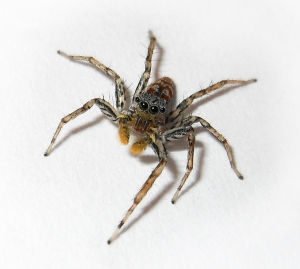You are here
East Coast Dreamin’: Six or Eight Legs at a Time
Arriving to Harvard Forest from drought stricken California, I could have never imagined a place with so much water and lush green vegetation; precipitation so thick that the trees "rain" for hours after warm summer showers, rivers hugging every winding country road, and lakes bursting at the seams. New England is a magical place where no one must consider turning their fluffy turf grass yard into a succulent garden or rockscape in response to the west coast drought.
Looking out a car window across a sprawling valley, one tries to comprehend how many hundreds of metric tons these trees occupy in biomass, all while imagining black bears foraging for food and turkey chicks following their mums diligently through the forest. Life thrives in every direction here.
Snow White would have been very happy to live at the Harvard Forest. Heck, she may have even chosen to become an Ecologist!
When we imagine Snow White's Harvard Forest, chipmunks, birds, and trees fill our minds with a tune. The creatures we do not think about are those that are very small, yet still incredibly important to the forest ecosystem. Of these miniscule giants, are the many different ants that live at the Forest, whom I am here to study.
These small soldiers that can defy gravity by dragging something many times their size across a ceiling may seem unimportant to humans, yet they play very important roles in their forest ecosystem. Ants live in trees, the soil, leaf litter, and just about any other substrate in the forest you can think of. Ants are responsible for breaking down dead arthropods and even small vertebrates, aerating and producing soil, and even dispersing seeds. They live very different lives from one another. Some are foragers and others are farmers, some live in large mounds or oak trees, and some spend their entire lives in a single acorn. Many of these creatures' lives are a mystery to humans, so me and Roxanne Hoorn, under the guidance of Dr. Aaron Ellison, set out to learn more about the lives of the Harvard Forest ants.
Several of our early experiments failed. Who would have thought that ants, with their complex societies and behaviors, would be so difficult to study? I say that with the wink of an eye.
We initially attempted to track ants of the genus Aphaenogaster as they moved nest sites. We spent hours painstakingly marking every individual of many captured colonies, painting hundreds of ants one by one with brightly colored paint with pine needles as tiny paintbrushes. We thought we were getting excellent data as we rediscovered our colored ants at their new nest sites, until we realized we had been outsmarted. The ants were grooming off their painted markings! We found trails of tiny gaster-shaped paint chips under the bark of fallen trees and leaf litter. The ants had officially flipped us the bird and moved on with their important little lives. We learned a lot through this period, especially about ant behavior with many hours of observation under our belts.
With the knowledge and experience we have gained, we formulated another project that we are currently working on, investigating some of the behaviors observed in the field between different kinds of ants. The relationships between different kinds of ants could involve territorial exclusion of certain genera and species from different substrates on the forest floor. To investigate this we are taking biodiversity surveys of ants in multiple areas. We are excited to see what our data tells us when we are able to analyze it this week.
Aside from my studying ants at the Harvard Forest, the staff and my coworkers have all been very supportive of my interest in spiders. Throughout the summer I have been cataloguing spiders that I come across at the Harvard Forest by photographing them and doing my best to identify them and rerelease them into the wild. I have catalogued over forty species during my two months here, many of which were provided to me from other student researchers' field sites. (Thanks y'all!)
This summer experience has been incredibly valuable to me. I have learned a lot about myself as a person, and even more so about the scientist I hope to become in the future. My first time on the East Coast has been a memorable one.
So long and thanks for all the [Cabot] cheese!



